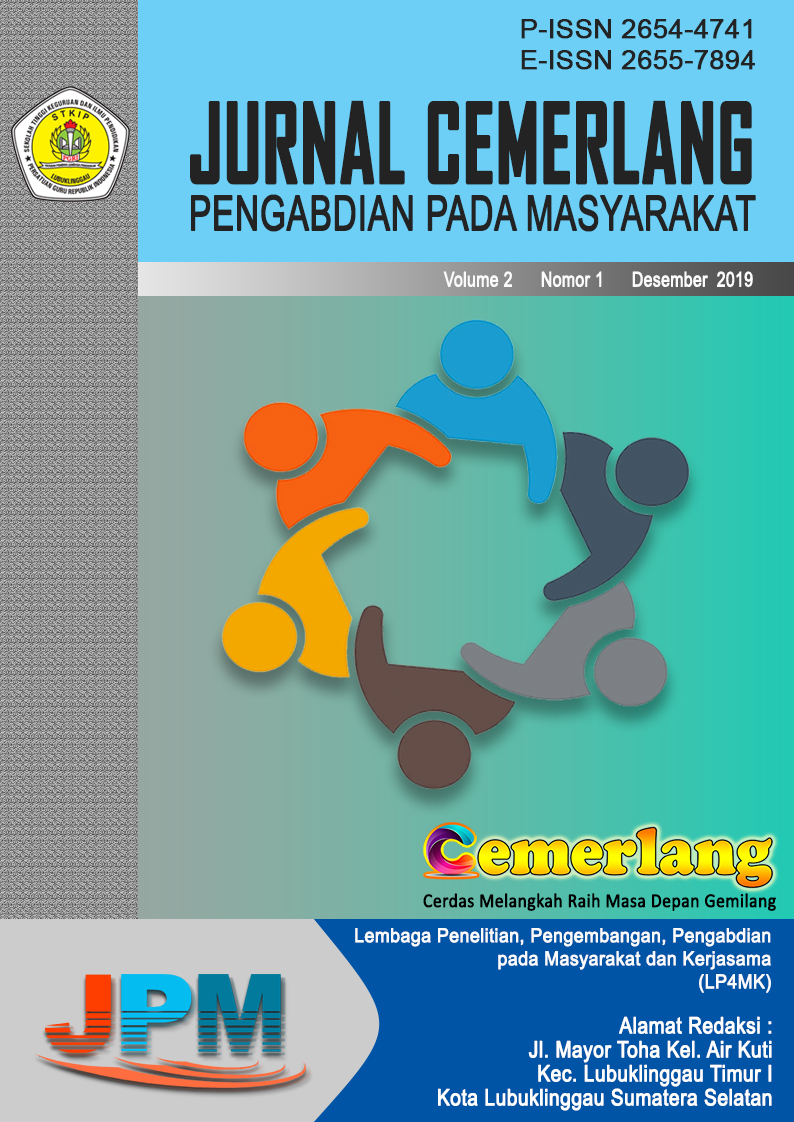PEMANFAATAN BARANG BEKAS SEBAGAI MEDIA PEMBELAJARAN KOSA KATA BAHASA INGGRIS
Abstract
The learning component is needed to support an effective and efficient learning process. One of those components is the media. Some studies find the lack of use of media in teaching English to early childhood, especially the teaching of vocabulary. Therefore, this service aims to equip teachers' skills and creativity in making English learning media by using items in the surrounding environment, especially used materials such as cardboard, bottled water, paper, straws, etc.. The method used in this service is training. Training was given to English teachers in Jalancagak Village, Subang on August 10, 2019. As a result, the teacher was basically capable and quite creative in utilizing used materials as learning media. However, this must continue to be motivated and developed so as to create innovative and attractive learning. Some of the instructional media produced are snakes and ladders, letter boards, and car puppets. Learning media from used materials, however, has advantages that are not inferior to technology-based learning media. In addition to the low cost, the rules of utilizing used goods are easy and familiar to students. In addition, teachers can also develop students' creativity by inviting them together to make media from used materials.
References
Cameron, L. (2001). Teaching Languages to Young Learners. Cambridge: Cambridge University Press.
Ekayanti, P. (2017). Pentingnya Penggunaan Media Pembelajaran untuk Meningkatkan Prestasi Belajar Siswa. Tersedia pada https://www.researchgate.net/publication/315105651
Hatch, E. & Brown, C. (1995).Vocabulary, Semantics, and Language Education. Cambridge: Cambridge University Press.
Kilic, M. (2019). Vocabulary Knowledge as a Predicator of Performance in Writing and Speaking: A Case of Turkish EFL Learners. Diakses pada 1 Agustus 2019. Tersedia pada http://www.culi.chula.ac.th/publicationsonline/files/article/u6dAOH6UZ9Mon104354.pdf
Lee, J.Y & Wong, A. (2017). The Relationship Between Leisure Reading Habits, Vocabulary, and Writing of English Language Learners (ELLs). Diakses pada 1 Agustus 2019. Tersedia pada http://www.leia.org/LEiA/LEiA%20VOLUMES/Download/LEiA_V8_I2_2017/LEiA_V8I2A03_Lee_Wong.pdf
Mutohhar. (2009). Teaching English for Young Learners (TEYL) Misunderstanding about TEYL in Elementary School. Retrieved on August 6, 2014, from: http://id.scribd.com/doc/97613317/
Prasetyo, M.A. (2017). Barkas (Barang Bekas) Sebagai Media Pembelajaran Tepat Guna Untuk Pembelajaran Bahasa Inggris. Diakses pada 6 Agustus 2019. Tersedia pada https://guraru.org/wp-content/uploads/2017/05/Artikel-BARKAS.rtf
Riyana, C. (2008). Konsep dan Aplikasi Media Pembelajaran. Makalah pada Kegiatan Pengabdia pada Masyarakat.
Sen, Y & Kuleli, M. (2015). The Effect of Vocabulary Size and Vocabulary Depth on Reading in EFL Context. Diakses pada 1 Agustus 2019. Tersedia pada https://pdf.sciencedirectassets.com/277811/1-s2.0-S1877042815X00371/1-s2.0
Smaldino, E.S., Lowther, L.,D., & Russell, D.J., (2007). Instructional Technology and Media for Learning. New Jersey: Pearson Prentice Hall.
Sukmahidayanti, T. (2015). The Utilization of Instructional Media in Teaching English to Young Learners (A Case Study of an Elementary School Teacher in Bandung). Journal of English and Education 2015, 3(2), 90-100.

Jurnal Pengabdian Masyarakat by http://ojs.stkippgri-lubuklinggau.ac.id/index.php/JPM is licensed under a Creative Commons Attribution-ShareAlike 4.0 International License.













